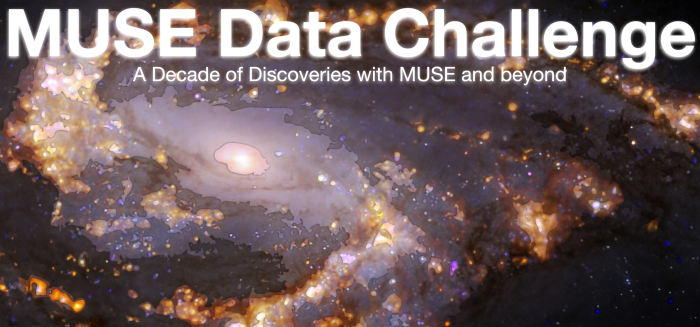MUSE Data Challenge

MUSE is the workhorse instrument of the VLT, and as such has been an integral part of modern astronomical research for the last decade. Dozens of astronomers have been involved in the data reduction and analysis of observations taken with this instrument. While a solid reduction pipeline has been developed and maintained by the MUSE Consortium and ESO, there remain ongoing issues that plague observing campaigns to varying degrees. Some of those are common challenges faced by most/all integral-field spectrographs and have been addressed in various ways by different teams. Chief among these are sky subtraction and flat fielding. These problems will persist and only become more prominent as the community continues to push MUSE to its limits over the next decade. The SOC/LOC have created a data challenge, choosing two issues that they consider to be integral to address for MUSE to further expand on the innovative science it has so far delivered. These issues are applicable to most modern IFS instruments and future facilities, making solving these problems timely and very relevant to the community over the coming decades.
The MUSE data challenge aims to share information, strategies, and best practices for mitigating these issues with the wider community. We will provide a set of raw science observations and associated calibration to any interested team or individual and ask that they apply their ideas to mitigate a given problem. These best efforts will be collated by the SOC/LOC and presented in November in a friendly and collegial manner. As a community, we will discuss the benefits and drawbacks of each approach, and for the first time, compare various techniques in an ‘apples to apples’ manner with a standardized set of data. We will encourage sharing this knowledge including promoting the outcome of this challenge in a Messenger article, or possible peer-reviewed journal article(s). Most importantly, we hope to understand the impact of various choices on MUSE data products and identify promising new and existing avenues for further work in this field.
Due Date: 5pm CET 27th October 2024
Challenge #1 – Flat fielding
Problem
Beyond the elaborate flat-field processing using dedicated calibration files, the MUSE Deep Field team has developed advanced self-calibration flat fielding techniques, using empty regions of their fields. Sadly, there is no equivalent of auto-flat-fielding for e.g., nearby galaxies, whose light typically overruns the entire FoV. The slicers signature may further affect the analysis of faint targets. Flat fielding may thus be one issue to be improved in some MUSE data and for specific MUSE science.
Challenge:
We will provide participants with a MUSE cube and ask participants to remove flat field effects to the best of their ability.
Data:
NGC 1311: https://archive.eso.org/downloadportal/ef8e7ab8-05be-4c0a-b88d-12aca4942dd6
Submission
1x fully-reduced datacube
3x images created from the cube in SDSS_g, SDSS_r, SDSS_i, and Hubble bands WFPC2_F814W, WFC3_F606W. These can easily be created via mpdaf cube.get_band_image routine.
1x colour image of the SDSS filters combined (you can make this look as pretty as you like using your desired scaling; this will simply be for illustrative effect.) Please use the format ‘lastname_galaxy_dataproduct.filetype’, for example:
Fraser-McKelvie_NGC1311_datacube.fits
Fraser-McKelvie_NGC1311_SDSS_g.fits
Fraser-McKelvie_NGC1311_SDSS_r.fits
Fraser-McKelvie_NGC1311_SDSS_i.fits
Fraser-McKelvie_NGC1311_HST_F814W.fits
Fraser-McKelvie_NGC1311_HST_F606W.fits
Fraser-McKelvie_NGC1311_gri.png
Please fill out this form.
Adjudication
- Judges to examine the datacube itself to look for any weird artefacts, examine collapsed ‘white light’ image for slicer artefacts.
- Comparison of the Hubble filter images to Hubble surface brightness profiles
Challenge #2 – MUSE Sky Subtraction
Problem:
The ESO MUSE pipeline offers several strategies for removing sky lines and continuum from an object spectrum, including modelling, taking a blank region of an object frame, or using an offset sky frame. Typically, no single approach is perfect, and sky lines and sky continuum often remain in reduced data, in part due to imperfect knowledge or consideration regarding the LSF variation, the sky variation, and data sampling. Many groups use some flavour of PCA analysis as an additional step, though without careful supervision, this process can also remove emission lines and other non-sky features.
Challenge:
We will provide two sets of MUSE data – one in which the object of interest fills the whole field of view, and one in which there is a large amount of empty sky in the field of view. Choose one or both datasets to perform your best sky subtraction on. Cleanest spectrum wins!
Data:
FCC 179 (object fills whole FoV): https://archive.eso.org/downloadportal/c18c4d7f-fa6d-42d9-a9f5-90d8c6135c6c
NGC 1311 (almost fully empty FoV): https://archive.eso.org/downloadportal/ef8e7ab8-05be-4c0a-b88d-12aca4942dd6
Submission
Reduced datacubes, white-light image, WFC3_F606W filter image and a short description of the steps taken. Please use the format ‘lastname_galaxy_dataproduct.filetype’, for example:
Fraser-McKelvie_FCC179_datacube.fits
Fraser-McKelvie_FCC179_HST_F606W.fits
Fraser-McKelvie_FCC179_whitelight.fits
Please fill out this form, and upload your data products to this folder.
Adjudication
Visual inspection of cubes, comparison to one another (and ESO Phase 3), comparison to reference imaging.
Notes
While we have provided links to the raw data and associated calibration files, participants are free to employ any archival calibrations in their response. Creative ideas employing the use of the ESO archive are particularly encouraged.
Due Date: 5pm CET 27th October 2024
Quick links
- Home
- Important dates
- SOC/LOC
- Invited speakers
- Code of conduct & chair guidelines
- Registration
- Fees
- Programme [Zenodo]
- Presentation guidelines
- Guidelines for talks
- Guidelines for posters
- Accommodation
- Travel
- MUSE Data Challenge
- Online tools
